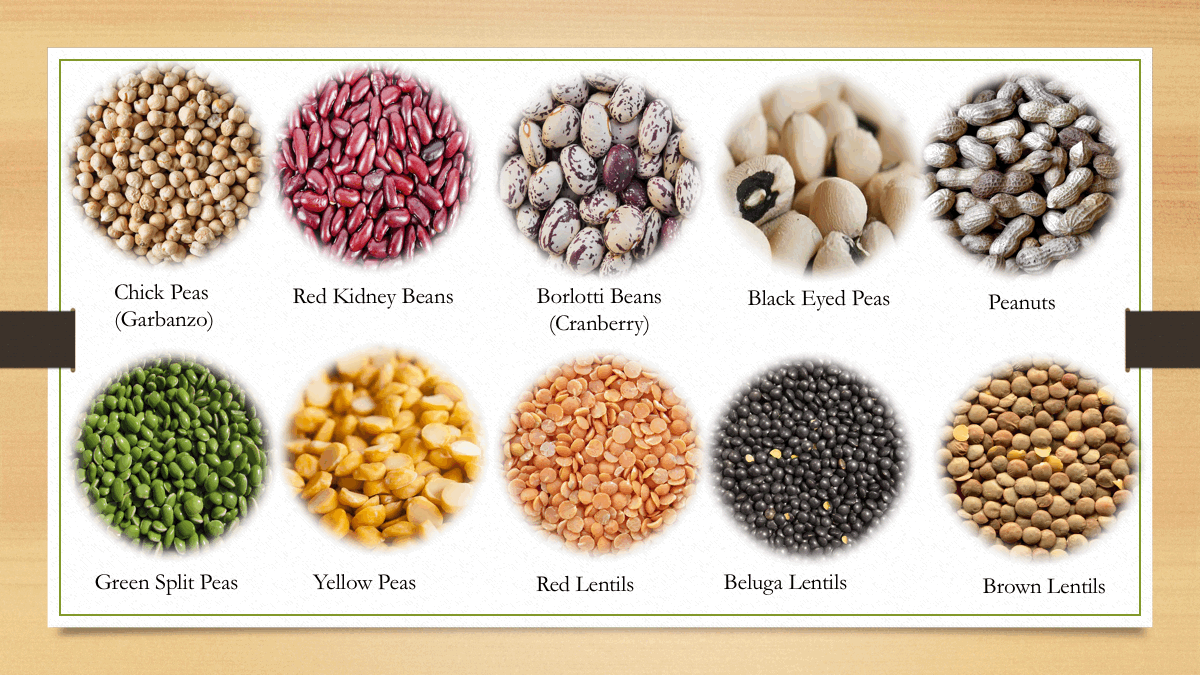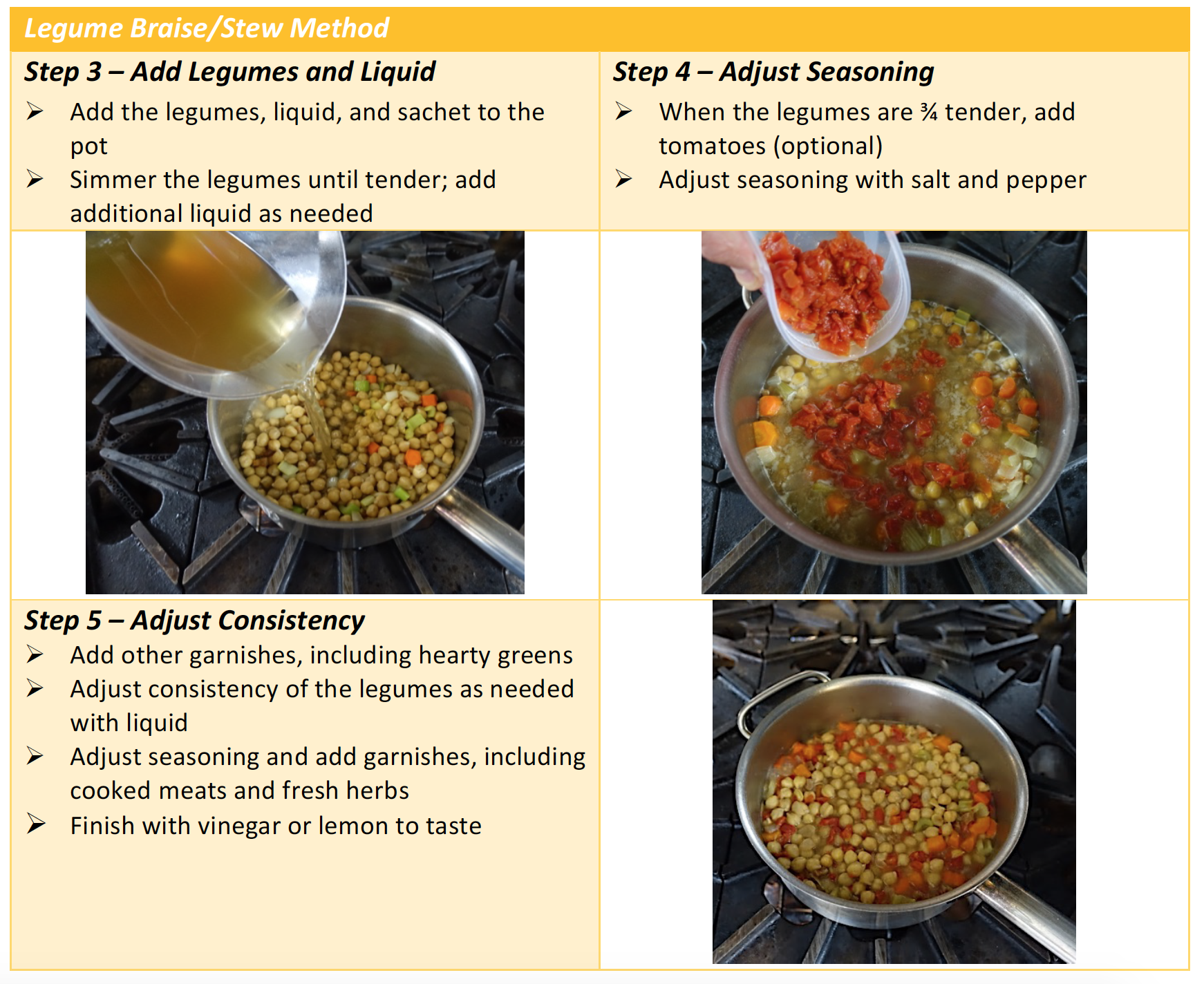Dried Legumes
Dried legumes are beans, peas, lentils, and peanuts that grow in pods and which can be eaten fresh but often are dried for storage and convenience. They are used is soups, stews, as sides dishes, or in salads and are rehydrated through cooking in liquids.
Dried legumes account for about 25% of farmed plant production in the world. Legumes are high in protein, iron, potassium, magnesium, and vitamin B and low in fat and calories. They are a cheap yet valuable source of protein that are eaten in cultures around the globe.
Prepping Legumes for Cooking
Dried legumes should be rinsed before cooking and sorted if necessary to eliminate any rotten ones. While peas and lentils can be simmered from a dry state in liquid to tenderize them, beans are often soaked in water to reduce cooking time. Although soaking does shorten the cooking time (usually about 20-30 minutes), it also results in a loss of flavor because soaking liquid is discarded which contains flavor. It should be noted that soaking does reduce the gaseous nature of beans by drawing out lectins and phytates and activating enzymes that break down indigestible starches and sugars making them easier to digest. But if you’re looking for more flavor, skip the soaking step.
Long Soak & Quick Soak Methods for Beans
For the long soak method, rinse the beans in cold water and sort out any bad ones. Place the beans in a container and add four times the amount of water and add 1 Tb./15 grams of salt per quart/liter. Soak at room temperature or refrigerated for 4-12 hours (see chart). Discard the soaking liquid and rinse beans before proceeding with the cooking process.
For the quick soak method rinse the beans in cold water and sort out any bad ones. Place the beans in a heavy bottom pot and add four times the amount of water. Bring the beans to a simmer and shut off the heat. Place a cover on the beans and let sit for 1 hour. Rinse the beans and proceed with the cooking process.
Pressure Cooking Legumes
Pressure cookers are helpful in reducing cooking time, and depending on the legume, can be cooked from a dry state in less than an hour. Presoaked beans will stay intact better than unsoaked beans when they are pressure cooked. For 1 lb./450 g of beans add 2 qt./2 liters of liquid along with 1/2 lb./450 g aromatics of onion, celery, carrots and garlic. Add a sachet of bay leaf, thyme, parsley, and peppers for seasoning. Beans tend to foam while cooking and can clog the pressure valve so add 1-2 TB./15-30 g of oil per lb./450 g of beans. Cook on 15 psi pressure for recommended time.
Salt & Beans
Salting beans tends to slow the cooking process but does help the beans hold their shape better. It’s better to salt the soaking liquid, and then rinse the beans before cooking. A ham hock, bacon, or salt port is sometimes added to legumes when cooking. This will add a little salt but not too much to hinder the tenderization time. Adjust with added salt after they have tenderized.
How Much to Use
For soups use 1-2 Lbs. /450-900 g of legumes per gallon/4 liter of liquid. For stews and salads use a 2:1 ratio of liquid to legumes. Legumes will double or triple in volume when rehydrated (8 oz./240 g legumes will yield about 1 lb. 4 oz./550 g).
Cooking Legumes
For soups and stews, sweat aromatics of onion, celery, carrots and garlic, in fats such as bacon or salt pork using 1/2 lb./450 g per 1 lb./450 g of legumes. For vegetarian recipes substitute olive oil and vegetable stock for pork or other meats.
Add other aromatics as desired including fresh or dried chilies or bell peppers. Add the legumes and liquid including water, chicken, or pork stock. Beer may also be added for part of the liquid (8-12 oz./225-375 ml per 1 gallon/4 liters of stock). Add a sachet of bay leaf, thyme, parsley, and peppers for seasoning; other herbs and spices can be added depending on the flavor profile desired. For an Asian flavor use soy sauce, kombu, ginger, and lemon grass. For a Tuscan flavor, sweat aromatics in pancetta, add garlic, pepperocino (red chili flakes), parmigiana, and rosemary. Simmer legumes gently in liquids using the recommended amount for soups, stews, or salads (see above). Simmer gently rather than boil to prevent beans from rupturing. For beans that hold their shape better, simmer uncovered; cover the cooking pot for creamier results. Acids in vinegar, tomato, wine and fruit along with sugar will prevent beans from softening; add these towards the end of the cooking process. Finishing the legumes with a little acidity of lemon juice, or vinegars of sherry, rice, or wine, brightens the starchy taste on the palate.
Tips:
Salt the soaking liquid for beans but not the cooking liquid
Soak beans using a 4:1 ratio of water to beans
Lentils and peas do not need soaking
Legumes will double or triple in volume when rehydrated and cooked
Older legumes take longer to cook because they are dryer so cooking times may not always be accurate
Baking soda aids in tenderizing beans but too much will make the beans taste soapy (use ⅛ tsp. per cup of beans)
Hard water containing high levels of calcium prevents beans from softening, use distilled water to resolve this problem
Pressure cooking legumes can reduce the cooking time by as much as 70%
Storage
Legumes will keep up to one year when stored in a cool, dry place in a sealed container
Red Bean Toxicity
Red beans, and to lesser extent white beans, contains a toxic compound called phytohaemagglutinin that can induce nausea and vomiting if the beans are not cooked properly. This toxin can easily be deactivated by boiling beans for ten minutes at 212 °F/100 °C. The USDA also recommends soaking beans for at least 5 hours and discarding the liquid after soaking.
Dried Legume Cooking Chart
For simmering, stewing and braising
Braised Legume Dishes
Tuscan Cannellini Beans – Sweat 8 oz./225 g mirepoix (onions, celery and carrots) in 4 oz./120 g diced pancetta and 2 oz./60 ml olive oil. Add ½ oz./15 g garlic, and ½ tsp. red chili flakes. Add 1 lb./ 450 g cannellini beans and 2 ½ qt./2 ½ L pork or chicken stock. Add a sachet of bay leaves, parsley, thyme, rosemary, and crushed peppercorns. Cook until beans are tender; add more liquid as needed. When
beans are tender, add 6 oz./ 170 g chiffonade of kale. Adjust seasoning with salt and pepper, and adjust consistency with water. Garnish with cracked pepper, a drizzle of balsamic vinegar, and Parmesan cheese.
Indian Curried Dal (Red Lentils) – Sweat 8 oz./225 g onions in coconut oil, add 1 ½ tsp. cumin, ½ oz./15 g minced ginger, 1 -2 green chili peppers (jalapeno, serrano, seeded & minced), ½ oz./15 g minced garlic cloves, and 2 tsp. curry powder. Add 1 lb./450 g red lentils, 2 ½ qt./2 ½ L water, and 8 oz./ 225 g tomatoes. Simmer until the lentils are tender; adjust consistency with water. Adjust seasoning with salt
and pepper. Served with lamb, rice, and raita.
Brazilian Feijoada (Black Bean Stew) – Sweat 8 oz./225 g onions, 1 oz./30 g garlic, and 2 bay leaves in olive oil, add 1 lb./450 g sliced Spanish chorizo, 1 ham hock, 1 lb./450 g black beans, and 2 ½ qt./2 ½ L water. Bring to a simmer and cook until the beans are soft. Pull the meat from the ham hock and add back to the beans. Mash ¼ of the beans to thicken the stew. Adjust seasoning, and add more water as
needed. Serve with braised greens and rice.
Braised Black-Eyed Peas with Ham Hock and Collard Greens – Soak peas overnight in water and drain. Sweat 8 oz./225 g onions in oil. Add ½ tsp. allspice, and ½ tsp. crushed red chili flakes. Add the blackeyed peas, ham hock, 2 ½ qt./2 ½ L chicken stock or water, and a standard sachet of bay leaves, parsley, thyme, and crushed peppercorns. Bring to a simmer and cook until the black-eyed peas are tender. Adjust seasoning with salt and pepper. Remove the ham hock and pull the meat from the bone and reserve. In a sauté pan, heat oil and add 1 lb./450 g collard greens with ½ oz./15 g minced garlic and ½ tsp red chili flakes. Add 4 oz./120 ml water and the chopped ham to the greens. Cook the collard greens until tender; adjust seasoning with salt and pepper. Serve the beans topped with the collard greens.








